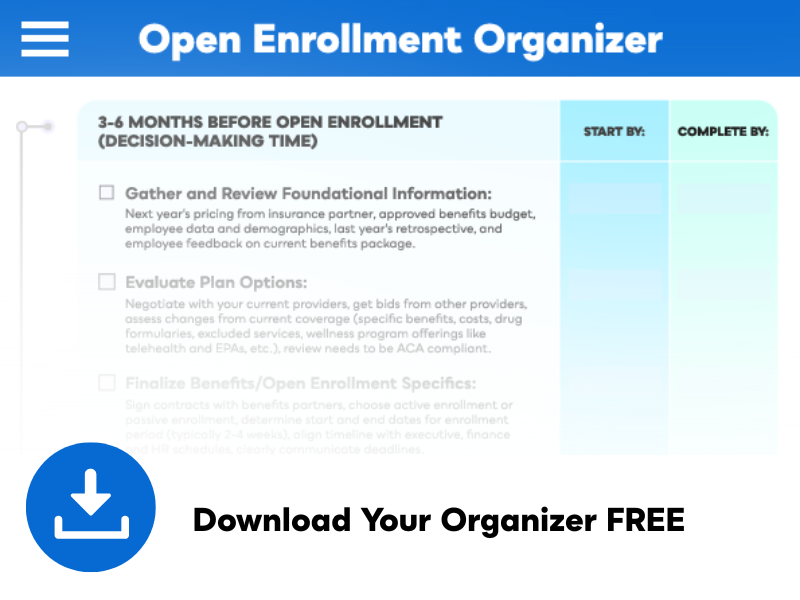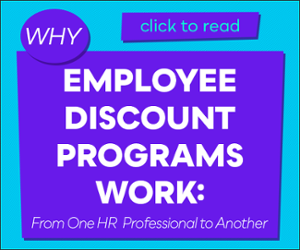Have you been past the human resources department lately?
Ceiling-high stacks of papers waiting to be filed threaten to crush those beneath under the weight of their importance. A mug of coffee grows cold, forgotten as another wave of tasks beat down the doors and pour in through the windows. HR professionals shuffle past, unfocused eyes ringed with dark circles. Can they even see you past the deluge of emailed questions and technical issues flooding their computer screens?
Sound a bit like the zombie apocalypse? Yah, it feels that way too.
 Companies with a January-start to their benefit year (the majority of U.S. companies) are already deep in the trenches of open enrollment season.
Companies with a January-start to their benefit year (the majority of U.S. companies) are already deep in the trenches of open enrollment season.
Thankfully, open enrollment isn’t doomed to be a grueling battle against a relentless horde of challenges. With strategic planning, HR departments can streamline the process and reduce the stress for everyone involved.
Jump to the end of the article for a comprehensive open enrollment organizer available to download for FREE.
Open Enrollment: Defined According to HR Professionals
Open enrollment means something very different to HR professionals than it does to every other employee in the company. To employees, it’s the short window of time (typically 2 weeks, maybe up to a month) they can sign up for and/or make changes to their employee benefits without any qualifying event.
To HR Professionals, open enrollment is an entire season with months of preparation, decision making, coordination with upper management and service providers, etc., before the main event even begins.
Then finally, the window closes and they can breathe a sigh of relief, right?
Ha! HR has another month or more of active effort to sort out and finalize every last detail. Add to that, the 60% of companies that hold open enrollment in October or November are simultaneously tasked with holding holiday parties, annual reviews and other typical year-end events.
At this point, you may consider HR’s open enrollment season officially closed. However, open enrollment is just one part (albeit a major part) of a company’s benefits administration strategy. In order to make employee benefits an integrated part of your employee engagement efforts, benefits administration takes consistent, year-round effort.
Is it any wonder burnout is especially high among HR professionals during open enrollment?
In this article, we’ll discuss why open enrollment deserves so much of HR’s attention. Then, we’ll try to help make this challenging season a little easier by breaking down the many tasks into a manageable timeline.
Below is a clickable timeline-at-a-glance. Feel free to click any section to jump ahead. Or, read through the full guide to ensure no step falls through the cracks.
A Crucial Component of Employee EngagementAs an HR professional, why do you care so much about one 2-week period you spend up to half a year focused on making it a success?
The biggest reason? Employees care about their benefits. A lot. Behind only wages, benefits are the second biggest factor employees look at when considering accepting a position at a new company or staying with their current employer. If you look at pay and benefits together under the term “total compensation,” then this is by far the most important factor to employees.
Open enrollment is a great time to showcase your benefits, announce new perks and remind your employees how much you care about them. The quality of a company’s benefits can have a profound effect on employee engagement, recruitment efforts and retention.
Consider these statistics from the past year that show the power of well-received benefits:
- 83% of employers believe their benefits are a major contributor to employee satisfaction
- 82% of job seekers consider the benefits package to be a top factor when considering whether to accept a job offer
- Employees who have a positive experience with their benefits are 1.9x more likely to trust their employer and 2.4x more likely to feel holistically healthy
Interestingly enough, as much as employers think their benefits are well received, other studies suggest it may not be the case:
- 74% of employers believe their employees are satisfied with their benefits, 67% of employees agree
- 51% of employees are unsatisfied with their benefits package
This could be due, at least in part, to employees understanding their benefits less than employers expect, according to several studies:
- 38% of employees struggle to understand their employer’s communications around benefits and open enrollment
- Nearly half of employees spend less than 20 minutes reviewing information on their benefits during the open enrollment period
- 86% of employees are confused by their benefits
People tend to procrastinate complex decisions like choosing healthcare benefits, even when a mistake means they have to wait a whole year (or for a life event) before they can make changes again.
In other words, human resources professionals are often expected to take open enrollment seriously enough for the entire company.
How to Survive Open Enrollment—with Your Sanity Intact
 With so many expectations (and negative consequences that can come from not living up to those expectations), HR professionals are highly susceptible to year-end burnout. Therefore, we turned to our own in-house human resources director, Lisa Oyler, to break down the massive task list into more manageable bites. With proper preparation and steady effort, open enrollment doesn’t have to drain the life out of you.
With so many expectations (and negative consequences that can come from not living up to those expectations), HR professionals are highly susceptible to year-end burnout. Therefore, we turned to our own in-house human resources director, Lisa Oyler, to break down the massive task list into more manageable bites. With proper preparation and steady effort, open enrollment doesn’t have to drain the life out of you.
3-6 Months Before Open Enrollment (Data-Gathering/Decision-Making Time)
Before your open enrollment window can open, everything must be in place behind the scenes. Starting months in advance, you’ll have a data-gathering phase, followed by a decision making phase, and then a preparation phase.
Starting the process as early as you can will help ensure you have everything prepared by your goal date. This is especially important for companies that hold open enrollment in Q4 for two reasons. Firstly, every day of delay brings you closer to the holidays (meaning you’ll have to compete for your employees’ attention). Secondly, you’ll have a tighter turnaround before your benefits year begins to complete your post-enrollment tasks.
“When it comes to open enrollment, every ounce of preparation before the big event pays out in pounds,” Oyler said. “Employees will face a torrent of information, but your efforts can give them a well-lit path by which they can navigate the choices. The work is worth it when it gives employees a better chance of choosing the benefits that will best fill their individual needs all year long.”
Gather Your Information
Will you stay with your current health insurance provider? Will you need to search for a new one? Will you need to change the plan structure? Before you can decide, you’ll need some crucial pieces of information:
-
- Next Year's Pricing from Your Current Insurance Partner. Begin the process by reaching out to your existing insurance provider for two things: usage data from the previous year and the pricing structure for the upcoming year. You can start asking about halfway through your benefits year, because providers typically need 6+ months’ worth of claims from your employees before they calculate pricing for the following year.
- Employee Data and Demographics. Compile a comprehensive dataset encompassing employee information, demographics, and any recent life changes that you know about. The better you understand your workforce and their specific needs, the better you can choose plan options that will serve them, and give them a good reason to stay.
- Company’s Projected Budget. Experts are predicting health insurance premiums will increase by 6-7% in 2026. Who will absorb the added costs? Will the company increase their budget, will you pass the cost on to employees, or will both need to share the burden? Ask for access to the budgetary decisions made by company leaders. This financial blueprint will be instrumental in aligning benefits offerings with the company's overall strategic goals.
- Last Year's Retrospective. Reflect on notes from the previous open enrollment, focusing on both successes and challenges. Use these insights to inform your strategy, capitalizing on what worked well and addressing areas that need improvement. If you’ve never written a post mortem before, learn how to start this year below. See section: Write a Detailed Retrospective
Evaluate Plan Options
After you’ve had a chance to analyze this information, you’ll need to decide whether to negotiate with your current provider or get bids from other providers.
Answer important questions like: Does the provider’s pricing for next year fall inside your budget? Do the options still adequately cover your current workforce? Was your benefit provider helpful and responsive?
If you choose to negotiate with your current provider, fine-tune next year’s quote. If employee needs have evolved, for example, learn whether additional inclusive benefits and/or more robust coverage fall inside your budget. Alternatively, you can try to make the benefits more affordable for everyone by negotiating the contract, sacrificing unused features, adjusting deductibles, etc.
If you’re unhappy or unsure about next year’s pricing from your current provider, going out to bid from other providers can be an efficient way to keep costs low without sacrificing options. Whether you’re working alone or with a broker, seek out quotes to present to your company’s decision makers.
Finalize Benefits/Open Enrollment Specifics
Working with company decision makers, finalize the benefits provider you’ll be partnering with and the options you’ll be offering. Then, you can choose exactly how you want to run the event internally.
First, schedule the dates open enrollment will start and end (typically a 2-week period). These dates will need to work with executive, HR and payroll schedules. Next, decide on the enrollment approach, whether it's an active enrollment (requiring all employees to make selections) or a passive enrollment (existing choices roll over unless otherwise specified). This decision shapes the dynamics of your communication strategy. Many employees favor the ease of passive enrollment because if they like their benefits, they don’t have to do anything to keep them going. On the other hand, active enrollment may take more effort for everyone, but it provides many opportunities to educate and engage employees throughout the process.
Update Employee Records
Outdated or incomplete records can lead to major headaches later—from missed dependents to payroll errors.
Take time to verify all employee information, including personal details, dependents, and beneficiary designations. Encourage employees to log in and double-check their own profiles. Then, coordinate with payroll administrators to confirm that employee data syncs correctly with your benefits enrollment platform. A little proactive cleanup now prevents confusion and corrections later—and saves your team hours of backtracking once the enrollment window is live.
Coordinate with Carriers, Third-Party Administrators, and Vendors
Open enrollment is rarely a solo effort. Between insurance carriers, third-party administrators, brokers, and benefit vendors, there are a lot of moving parts (and they all need to move in the same direction).
Schedule time to connect with each partner well before enrollment begins. Confirm that data connections, file transfers, and carrier integrations are running smoothly. Make sure everyone has the materials and timelines they need, and establish a clear protocol for handling technical issues or last-minute questions.
Also, don’t forget to align on employee support procedures. Decide who answers which types of questions, and how quickly. A coordinated approach builds confidence, reduces delays, and ensures a smoother experience for everyone involved, especially your employees.
1-3 Months Before Open Enrollment (Preparation Time)
Once the decisions are made—providers hired, plan options chosen and enrollment platform secured—it’s time to prepare all the resources employees will need to have a successful open enrollment.
Update/Prepare Enrollment Education Materials
Once you’ve signed the contract and locked in your choices, it’s time to create your benefit guide. This is a summary of options and pricing for your employees to use as a resource when selecting their coverage.
Can you anticipate where employees might get confused or need additional instruction? If so, you can avoid answering the same question over and over again by developing comprehensive FAQs. You’ll probably need two sets: one to cover the registration process and another to keep on hand when it comes time to use their benefits throughout the year. For best results, the “explain it to me like I’m five” sentiment applies.
In addition to FAQs, other at-a-glance resources like summary snapshots, rate sheets, cost comparisons, list of in-network locations, glossary of benefits terminology, short videos, etc., can make large amounts of information less overwhelming.
Test Enrollment Systems Well Before Rollout
Nearly a third of employees procrastinate selecting their benefits. You can help prevent last minute scrambles by ensuring the enrollment process is seamless and user-friendly instead of frustrating.
After you’ve selected your provider and options, but long before official rollout, the enrollment system will need to be thoroughly tested. For many, that looks like taking multiple test runs through the diverse options your employees may encounter. Play the part of a 43-year-old male with a large family, a single 26-year-old female, a married 64-year-old currently working part time, etc. As you go, look for technological glitches, incorrect information, issues with pricing, or anything else that could frustrate the process.
Plan Your Communication and Engagement Strategy
Planning your communication schedule ahead of time will give you the space to thoughtfully create the most useful and impactful strategy. Not only that, you can write email updates and schedule reminders ahead of time so those important tasks don’t get lost in the scramble that comes later. Many of the communications [internal link] and extras [internal link] that will help keep energy and attention high during open enrollment will need to be planned and scheduled beforehand. For example, visiting vendors have to be scheduled, testimonials have to be solicited, incentives have to be purchased, etc.
As you plan your communication and engagement strategy, remember the following best practices:
-
- communicate early & often
- establish training/meeting schedules
- use different delivery methods, offer ongoing support
- provide easy-to-find educational resources/visual aids
- use one simple & memorable message per communication
- segment your audience (e.g., families, single employees, early-career, nearing retirement) and plan specialized messaging for each
Set Employees up for Success
Ideally, your employees will already know what options they want to pick before the open enrollment window even opens. That way, the only thing standing between them and successfully completing their open enrollment is a few forms and button clicks.
To make this happen, provide information in the weeks before your open enrollment window, such as educational information for each benefit or fliers from providers. In those same weeks, meeting together as a company gives you the opportunity to announce changes and invite questions in a collaborative atmosphere. Many companies also find it helpful to invite their benefits providers and vendors to come on site (or Zoom in) for company-wide meetings, one-on-ones or consultations with spouses/significant others. Those who want extra clarity on benefit options often find these to be very helpful.
Finally, send a countdown so no one is surprised when the window opens.
During Open Enrollment (Go Time)
When the open enrollment window is open, your role is to stay on top of everything by monitoring enrollment numbers, fixing issues and guiding employees through the process. After months of researching, testing and studying every minute detail, you as the HR pro are now the expert when it comes to benefits options. But remember, the rest of the staff are not, and the short window doesn’t give them enough time to become one. Is it any wonder that 77% of employees have expressed they just want someone else to tell them what the best plan is for them?
“HR is in the perfect position to act as translator between employees and the intricate world of health benefits,” says Oyler. “Education + encouragement = empowerment for every employee to make the right decision for themselves. Plus, every interaction during this time is another chance to make employees feel appreciated.”
Communicate, Communicate, Communicate
Reminding employees about deadlines is one of the most important things you can during the open enrollment window.
The great news is, ANY communication that talks about an aspect of open enrollment will naturally turn employee attention back to the task at hand. The topic is so large that you can easily send several communications a day without repeating messages or feeling pushy.
For best results, mix up the message AND the mode of communication. Here are some ideas:
-
- Give explanations of common voluntary benefits like life insurance, vision insurance, etc., and reasons why a person might like to opt in.
- Call for questions, and remind of the channels available to ask.
- Remind employees about available resources and provide links, attachments or physical copies of those documents.
- Send invitations to meetings and events
- If you have a budget or can get donations from providers, offer prizes or a drawing for those that complete their enrollment early.
Open Your Door
An open-door policy can actively encourage employees to seek clarification and assistance. Part of this is opening your literal office door, offering private sessions for employees to ask confidential or sensitive questions. Beyond that, if you leverage multiple channels of communication, employees can find help using the method that makes them comfortable. Some options include: face to face, over the phone, through email or via a public Slack or Teams channel.
Keep Energy High
Throughout all your many communications and efforts, be sure to sprinkle in some lightheartedness. Perhaps it would be helpful to think of open enrollment as the “spirit week” of benefits season. Where possible, add a few incentives into the mix. Raffles, drawings, and small prizes can go a long way in encouraging early enrollment. Some HR teams even run a “first-day entry bonus” for employees who complete their selections right away. It adds a sense of momentum (and saves you a last-minute scramble).
You don’t have to carry the load alone. Recruit internal champions or department influencers who can help spread the word and keep enthusiasm high. When peers share real-life examples—like how someone saved hundreds on prescriptions or discovered new mental health resources—benefits suddenly feel a lot more relevant.
Finally, make it a community effort. Invite brokers, carriers, and vendors to host Q&A sessions or short presentations, and consider a benefits fair (either in person or virtual). When employees can explore options hands-on and ask experts directly, they’re far more likely to select the right plan and therefore use the benefits your company works so hard to provide.
Roll Out Other New Benefits
Open enrollment is a great time to roll out all your new benefits, remind about continuing perks, and if necessary, remove some. This helps keep the focus on the benefits package as a whole being a part of one’s total compensation.
Many popular supplemental benefits and lifestyle benefits pair well with healthcare benefits. For example, gym stipends encourage physical fitness, EAPs support mental health, and employee discount programs aid those seeking wallet wellness.
Often, your benefit offerings will naturally complement your workplace culture. “One of the benefits we offer is a U.S. National Parks Annual Pass,” said Oyler. “This benefit and others reflect our company’s dedication to wellness, family time, the environment and the beautiful state we are based in. Every time we remind our employees about their benefits, we reinforce the culture that attracted them to us in the first place.”
Prioritize Your Own Wellness

The stress of open enrollment compels many HR professionals to run full speed for months, staying late and working extra hours to be ready. Then, to add insult to exhaustive injury, cold and flu season arrives at the same time as most companies’ open enrollment windows. What do you need in order to run at peak performance? Vitamin C, stress ball, blue light filtering glasses, guided meditation, extra sleep… grab all your favorites and schedule the time you need for self-care.
Plus, before you burn the midnight oil yet again, consider this: a survey of HR professionals showed a high correlation between those who routinely didn’t go home on time and those who were dissatisfied with many other aspects of the job. A healthy work/life balance is not just for the employees you serve.
1-3 Months Post Open Enrollment (Organization Time)
Once the window closes, HR still has a long list of tasks to complete. The months after open enrollment are filled with tiny details: double-checking each and every selection to make sure they’re correct. It’s easy to get lost in the minutia and lose sight of the big picture.
“When the goal for providing employee benefits in the first place is to retain and engage employees, the last thing you want is for people to ignore those benefits 90% of the year,” said Oyler. “Now that they’re done choosing, let’s get them using their benefits.”
Double Check Every Detail, Process Enrollments & Correct Errors
Once all the selections are locked in for the benefits year, HR acts as the link between all the various systems that have to get every detail right. Payroll is the first system that requires an audit in order to ensure everyone’s first paycheck of the benefits year includes the right deductions. You may have to channel your inner investigator if the confirmation statements don’t match the deductions.
Secondly, once the first bill from the benefits provider arrives, it’s important to go through it line-by-line (tedious and time-consuming as that may be) to ensure every employee is enrolled in the correct plan. Your vigilance in the immediate aftermath can save a lot of headaches down the line.
Lastly, make sure each employee received a new card, the correct written materials and everything else they need to succeed. Within the first month, you’ll need to be able to evaluate and report to executives on participation rates, plan selections, and any trends or patterns that you’ve noticed.
Once you’ve reconciled all these systems, the bulk of the work for open enrollment is finally complete!
Continue Educating, Engaging, Enrolling
Employee education should never stop. Immediately after open enrollment, you’ll want to provide detailed instructions about each employee’s benefits selections and how they can access those benefits/ID cards.
Then, the minute those benefits are live, break out the balloons, confetti and your best game plan to encourage usage. For example, a fun wellness challenge uses the principles of gamification to encourage employees to use their benefits early and often.
While the bulk of enrollment is done for the year, there will still be questions, new hires and life events that happen. So, stay ready to assist whenever the need arises.
Survey Your Workforce
The best time to solicit feedback on the processes and options presented at open enrollment is while it’s fresh on the employee’s minds. You can ask questions formally through a survey, or as informally as chatting as you pass employees in the hallways.
Try to keep the conversation focused on the things you can control, and possibly improve in the future. For example, it might be helpful to ask: Was the technology easy to interact with? Did the provided information explain the benefits at your level of understanding? Did plan options adequately cover your unique needs? Should the conversation devolve into complaints about the cost of healthcare in general (which, unfortunately, you can’t control), here are some ideas on how to address employee concerns.
A separate round of surveys will come in handy later on. Once everyone has had a few months to use their benefits, they’ll be that much better equipped to tell you specifics of what they like and dislike about their coverage and current provider.
Gathering this information at the right time will better guide your choices next benefit year.
Write a Detailed Retrospective
HR is bound to have many valuable insights into open enrollment, having been immersed in it for many months. These insights should be recorded before they’re forgotten.
What slowed you down? What was your most helpful technology aid? Which written resources are being used and which are not? How responsive is the benefit provider and how quickly do they resolve issues?
Perhaps the most useful thing you can do is investigate where things went wrong. If an employee missed a deadline, ask why. If multiple people misunderstood the same information, discover if there are holes in your communication. All these notes will save you time in the future because you can begin with the strategies that worked and avoid those that didn’t.
CELEBRATE!
Whether you’re a one-person-show or a part of an HR team, you deserve some recognition—and a rest. You did it!
3-9 Months Post Open Enrollment (The Off-Season)
The open enrollment off-season is free of the urgent tasks that require your immediate attention. However, there are still plenty of goals to shoot for. Easily completed any time of year, checking off these tasks early will help you enter the next open enrollment without having to cram in all the work at once.
Likewise, education about benefits is best reinforced regularly throughout the year.
“In HR, we’re constantly immersed in all things employee benefits,” said Oyler. “Employees are not. A topic this massive is best served in small slices throughout the entire year. If our education efforts are limited to once a year, it could feel like we’re force-feeding them way more than they can digest at once.”
Encourage Benefits Usage

Every time you remind employees about their benefits, it’s another chance to engage and encourage usage. But reminding shouldn’t be the only goal when discussing benefits—you should strive to educate employees on how to be better healthcare consumers. Do employees know when to use an instacare location instead of the ER? Do they know where to find a list of in-network providers to choose from? Have they scheduled preventative care visits for the year?
By turning our focus to educating employees in micro doses throughout the year (which helps employees better process and recall complex information), you can not only keep benefits awareness high today, but also build a future where premium costs stay lower for everyone.
Continue Your Own Education & Network with Industry Experts
The world of benefits, especially healthcare benefits, is constantly evolving. Staying ahead of the learning curve could make all the difference in your efforts to recruit (and keep) the best talent in the industry. These are some key areas to focus on:
Research Laws & Regulations in the Pipeline. At any time, federal, state and/or local governments can pass laws that will affect employment and employee benefits. For example, SECURE act 2.0 and One Big Beautiful Bill potentially require businesses to make significant changes to be compliant. A proactive approach—like keeping a watchful eye on bills and proposals so you’re not blindsided if they do get voted into law—can save a lot of grief in the long run.
Government pages like this one and this one can help you find relevant bills currently under review.
Research Potential Technology Aids. Every year, there are more and more resources aimed at making HR’s job easier. As AI technology rapidly improves, it promises even more timesaving aids in the near future.
Where are your biggest pain points? Perhaps a bit of research can lead you to a technology solution: advanced analytics to find insights in your employee data, AI chatbots to help field common questions, software to help you write compelling user guides. Recently, Lisa Oyler implemented the education platform Brite to help employees feel more confident learning what benefits are right for them.
Likely, every task on your list could use an upgrade. Researching options during the off season gives you extra time to not only select a few aids, but also test and implement them. When you pick the right technology, it’s an investment that could not only save you time and effort, but could vastly improve results too.
Research Wellness Programs and Other Lifestyle Benefits. With health care costs continuing to rise, more and more of an employee’s check goes to paying for premiums.
Creative benefits can potentially make a big impact with a much smaller price tag than salary and other types of compensation. When you research new benefits in the off-season, you give yourself the time to thoroughly vet benefits providers you want to partner with. For example, employee discount programs are very popular, but they are not all created equal. The best employee discount programs help stretch employee’s budgets on purchases they make every day. A discount program will be most relevant to your staff if it provides deep, local discounts on common expenses like food, clothing and services (and also some fun ones like travel and entertainment).
You can even provide helpful links to free programs like GoodRX to help provide a positive experience to those who decline health insurance benefits.
Clear Your Plate
The best way to start next year’s open enrollment season is with a fresh perspective and a clean plate. Are there any of your other regular tasks you can complete so they’re off your mental checklist entirely? Are there any of your many hats you can place on a shelf for a few months until the next offseason? Of course, issues and emergencies can happen any time of the year, but a proactive approach to predictable responsibilities gives you a better chance at a focused and streamlined process.
Take Your Vacation Days
Did someone say spring break? For HR reps with a January start to the benefits year, post enrollment reconciliation should wrap up sometime in February. That makes spring and summer the perfect time to use up all that PTO that has probably been building while you burned the midnight oil.
Rest. Recharge. Kick up your feet at home, in the mountains, across the ocean, on a beach… just make sure you leave your work in the office where it belongs.
Better yet, if your company offers employee discounts on travel, dining and leisure, then use those to build yourself a sweet vacation. Go ahead and tell your inner workaholic that you’re “testing the benefits for the sake of the employees” or that you’re “setting an example of good benefits usage.” As long as you’re recharging your battery at the same time, that’s okay.
Don’t Just Survive – Thrive!
 Just for fun: look to your right, and imagine that the first item you see is your only protection for the zombie apocalypse. Could you survive?
Just for fun: look to your right, and imagine that the first item you see is your only protection for the zombie apocalypse. Could you survive?
Luckily for you (and the company you serve) you have A LOT more tools and resources to not just survive open enrollment season, but make it a raging success too. Besides the survival guide above, we’ve got other articles (listed below) full of tips to bulk up your arsenal. This open enrollment season, you’ll be ready to face any challenge.
- Open Enrollment: 10 Tips for HR Professionals
- Cracking the Code to Employee Benefits Utilization: the Average vs. the Excellent
- You Can’t Spell Hero Without HR
- Employee Benefits Costs: 10 Ways to Combat Rising Health Insurance Prices
- Lifestyle Benefits: The Ultimate Guide
- What to do When Employees Complain About Their Benefits Costs
- Free Employee Discount Programs: 10 Secrets You Should Know

Fill out the form below to download your open enrollment organizer.
Available in both printable and digital formats.











